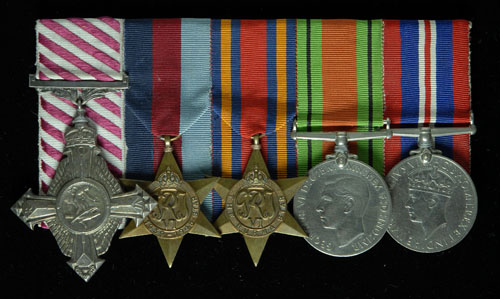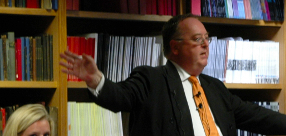
Auction: 9033 - Orders, Decorations, Campaign Medals & Militaria
Lot: 16
An Unusual and Well Documented 1950 ´Aerobatics´ A.F.C. Group of Five to Hurricane, Thunderbolt and Meteor Jet Pilot Flight Lieutenant R.E. Windle, 135 and 245 Squadrons Royal Air Force, Who Shot Down Two Japanese Aircraft During His Second War Service, and Was Shot Down Himself Over the Jungle, Surviving 29 Bullet Holes in His Hurricane´s Cockpit, 14.3.1943 a) Air Force Cross, G.VI.R., reverse officially dated ´1950´ b) 1939-1945 Star c) Burma Star d) Defence and War Medals, very fine or better, mounted court style for display, with the following related contemporary documents and other items: - Four Pilot´s Flying Log Books (29.8.1941-27.2.1961) - Named enclosure slip for the A.F.C. award - A file compiled by the recipient with a large number of photographs from various stages of his career, with typed notes of explanation and newspaper cuttings - An inspection panel from the roundel area of a Japanese Army 0I ´Oscar´ fighter aircraft shot down on the Arakan Coast of Burma by the recipient, 12.2.1943 - A framed oil painting of the Stradishall Meteor Formation Aerobatic Team performing over R.A.F. Stradishall, painted by Pilot Officer Price-Whittle, 1951 (lot) Estimate £ 1,800-2,200 A.F.C. London Gazette 2.1.1950 Flight Lieutenant Robert Edward Windle (173807) R.A.F. Flight Lieutenant Robert Edward Windle, A.F.C., born Kingston Upon Hull; volunteered for Aircrew Duties, August 1940, ´only a week before I was called up for full time service, a German bomber dropped a pair of ´land mines´ on parachutes on West Hull, one of which landed only 75 yards from my home. These bombs drifted down slowly and were fitted with a pressure detonator so that the one ton of explosives would explode at ground level. My family were lucky but as I heard the cries of those trapped, I distinctly remember saying, tearfully and with immense emotion, "I´ll get one for that"; the following month he was chosen for Pilot Training and posted to 5 Initial Training Wing, Torquay, 3.5.1941; posted for further training to No. 6 British Flying Training School (Harvards), Ponca City, Oklahoma, U.S.A.; gained his "Wings" January 1942; converted to Hurricanes before posted to 135 Squadron (Hurricanes), Dum Dum, Calcutta, ´The squadron was a ´Defence of Calcutta´ role until mid Jan. 1943 when the squadron moved forward, split into two flights on separate airfields. Our flight actually used a 10 mile length of beach as a runway situated on the Arakan coast about 15 miles south of Cox´s Bazaar nr. the India/Burma border. The jungle came almost down to the beach and when the tide came in, and at dusk, the aircraft were pushed back into jungle clearings. Our roles were as interceptor fighters and as close support, to the army at the front. Life was Spartan but morale was wonderful. Flying was all operational and always exciting. I managed to down a Jap. Army OI Fighter in February 1943. A month later I was shot down myself and was picked up by a special Army Unit who visited sites of shot down Japanese aircraft and collected pieces of interest to keep a check on Japanese modifications. The unit had recently visited the one I had shot down and gave me two pieces of that actual aircraft [see lot]........ Whilst waiting the army ran me back to my Hurricane and I counted 29 bullet holes in the cockpit area, I was completely unhurt´, his Log Book gives the following on the two incidents, 12.2.1943 ´Scramble 12 Army OI´s. One Army OI Destroyed´, and 14.3.1943 ´B.E. Jumped. Force Lobbed Hatchet. Sandy Morrison & Don Robertson Killed OI´s Intercepted By OI´s Shot Up´; after a gunnery course he rejoined the squadron at it´s new base at St. Thomas´s Mount, Madras, May 1943; moved with the squadron to Ceylon, January 1944, ´another strip in the jungle...... I collected my commission and malaria on the same day, lost two stone in two days. We converted onto Republic P47 Thunderbolts in June and prepared ourselves to move back to the forward area in the autumn..... in the October we moved forward to Chittagong E. of Calcutta and back onto operations with a role of long range escort to B. 29s and Liberators. Some of the sorties involved a 1,200 mile round trip and up to 6 hours, mostly over jungle. We also carried out long range fighter sweeps, hoping to attract Japanese fighters into the air and have them back on the ground when our bombers where over their target area. On one of these sweeps near Rangoon I managed to down another Jap. fighter, again an Army OI´, Windle´s Log Book gives the following, 17.11.1944 ´Sweep Rangoon Airfields 8+ Oscar II´s Sighted Got 1 Destroyed´; moved with the squadron to Jumchar, near Cox´s Bazaar, December 1944, ´Our role was interesting, dive bombing with 2 x 500lb bombs both close support to the Army and longer range target bombing using a 100 gallon long range fuel tank under the belly. We also used napalm bombs which were devastating...... Although we could see results on just about every mission we all wanted to see more enemy aircraft, to ´have a go!´ ; Windle served as an instructor at Amarda Road and Bhopal until V/J Day; on his return to the UK he was posted to 245 (Northern Rhodesia) Squadron (Meteor Jets), Colerne, Bath, and moved with the squadron to Horsham-St.-Faith, Norwich, August 1946; joined the squadron in Lubeck, Germany, December 1946; returning to the UK following year, before being re-equipped with Meteor IV´s by March 1948 and as a consequence of this, as was coined in one national newspaper at the time, he became part of the ´Worlds Fastest Fighter Squadron´; Windle was one of the founder members of the squadron´s aerobatic team, ´we did about 7 minutes formation aerobatics, loops, rolls, rolls off and split ´S´s. Then we would peel off and do about 4 minutes individual runs....... We did the show many times in front of sometimes large crowds and sometimes a select few like the Royal Family at Cranwell, the Shah of Persia, but the highlight was an overseas trip to Denmark, Copenhagen in October. Where we performed before 100,000 people along the seafront´; after a brief administerial posting Windle returned to 245 Squadron and the aerobatic team, with which he took part in the Defence Exercise displays in the Middle East, ´the Egyptian Government were so impressed that they ordered 50 Meteor IV´s for their own air force´; later postings, where he continued with aerobatic teams - often of his own organisation, included as Chief Ground Instructor 226 O.C.U.; 609 Squadron, March 1952 and after a break from the service returning to 245 Squadron at Stradishall, 1956; following a posting to the Air Weapons School, R.A.F. Leconfield, Windle retired 1961.
Sold for
£2,500




